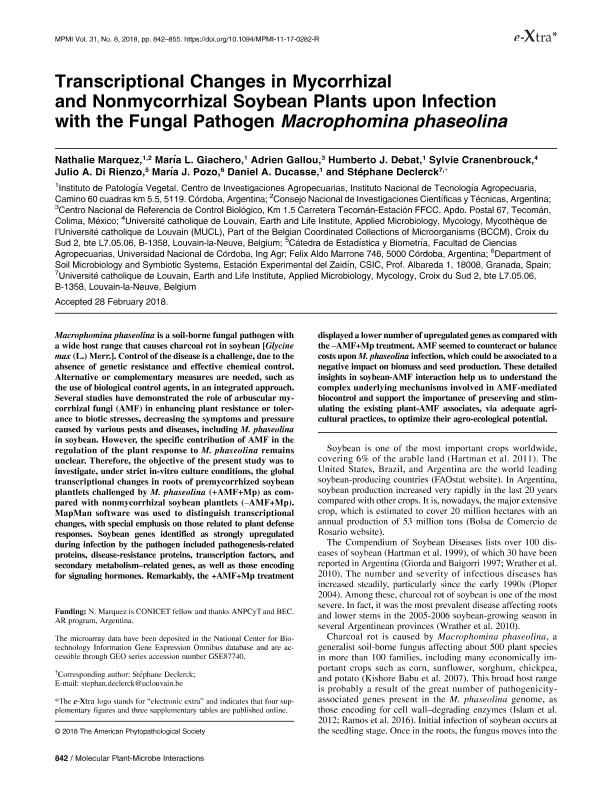Artículo
Transcriptional changes in mycorrhizal and nonmycorrhizal soybean plants upon infection with the fungal pathogen Macrophomina phaseolina
Marquez, Nathalie ; Giachero, María Lorena
; Giachero, María Lorena ; Gallou, Adrien; Debat, Humberto Julio
; Gallou, Adrien; Debat, Humberto Julio ; Cranenbrouck, Sylvie; Di Rienzo, Julio Alejandro; Pozo, María J.; Ducasse, Daniel Adrián; Declerck, Stéphane
; Cranenbrouck, Sylvie; Di Rienzo, Julio Alejandro; Pozo, María J.; Ducasse, Daniel Adrián; Declerck, Stéphane
 ; Giachero, María Lorena
; Giachero, María Lorena ; Gallou, Adrien; Debat, Humberto Julio
; Gallou, Adrien; Debat, Humberto Julio ; Cranenbrouck, Sylvie; Di Rienzo, Julio Alejandro; Pozo, María J.; Ducasse, Daniel Adrián; Declerck, Stéphane
; Cranenbrouck, Sylvie; Di Rienzo, Julio Alejandro; Pozo, María J.; Ducasse, Daniel Adrián; Declerck, Stéphane
Fecha de publicación:
08/2018
Editorial:
American Phytopathological Society
Revista:
Molecular Plant-Microbe Interactions
ISSN:
0894-0282
Idioma:
Inglés
Tipo de recurso:
Artículo publicado
Clasificación temática:
Resumen
Macrophomina phaseolina is a soil-borne fungal pathogen with a wide host range that causes charcoal rot in soybean [Glycine max (L.) Merr.]. Control of the disease is a challenge, due to the absence of genetic resistance and effective chemical control. Alternative or complementary measures are needed, such as the use of biological control agents, in an integrated approach. Several studies have demonstrated the role of arbuscular mycorrhizal fungi (AMF) in enhancing plant resistance or tolerance to biotic stresses, decreasing the symptoms and pressure caused by various pests and diseases, including M. phaseolina in soybean. However, the specific contribution of AMF in the regulation of the plant response to M. phaseolina remains unclear. Therefore, the objective of the present study was to investigate, under strict in-vitro culture conditions, the global transcriptional changes in roots of premycorrhized soybean plantlets challenged by M. phaseolina (+AMF+Mp) as compared with nonmycorrhizal soybean plantlets (−AMF+Mp). MapMan software was used to distinguish transcriptional changes, with special emphasis on those related to plant defense responses. Soybean genes identified as strongly upregulated during infection by the pathogen included pathogenesis-related proteins, disease-resistance proteins, transcription factors, and secondary metabolism?related genes, as well as those encoding for signaling hormones. Remarkably, the +AMF+Mp treatment displayed a lower number of upregulated genes as compared with the −AMF+Mp treatment. AMF seemed to counteract or balance costs upon M. phaseolina infection, which could be associated to a negative impact on biomass and seed production. These detailed insights in soybean-AMF interaction help us to understand the complex underlying mechanisms involved in AMF-mediated biocontrol and support the importance of preserving and stimulating the existing plant-AMF associates, via adequate agricultural practices, to optimize their agro-ecological potential.
Palabras clave:
Microarray
,
Transcriptomic
,
Mycorrhiza
,
Fungal pathogens
,
Transcriptomic
,
Mycorrhiza
Archivos asociados
Licencia
Identificadores
Colecciones
Articulos(CCT - CORDOBA)
Articulos de CTRO.CIENTIFICO TECNOL.CONICET - CORDOBA
Articulos de CTRO.CIENTIFICO TECNOL.CONICET - CORDOBA
Citación
Marquez, Nathalie; Giachero, María Lorena; Gallou, Adrien; Debat, Humberto Julio; Cranenbrouck, Sylvie; et al.; Transcriptional changes in mycorrhizal and nonmycorrhizal soybean plants upon infection with the fungal pathogen Macrophomina phaseolina; American Phytopathological Society; Molecular Plant-Microbe Interactions; 31; 8; 8-2018; 842-855
Compartir



